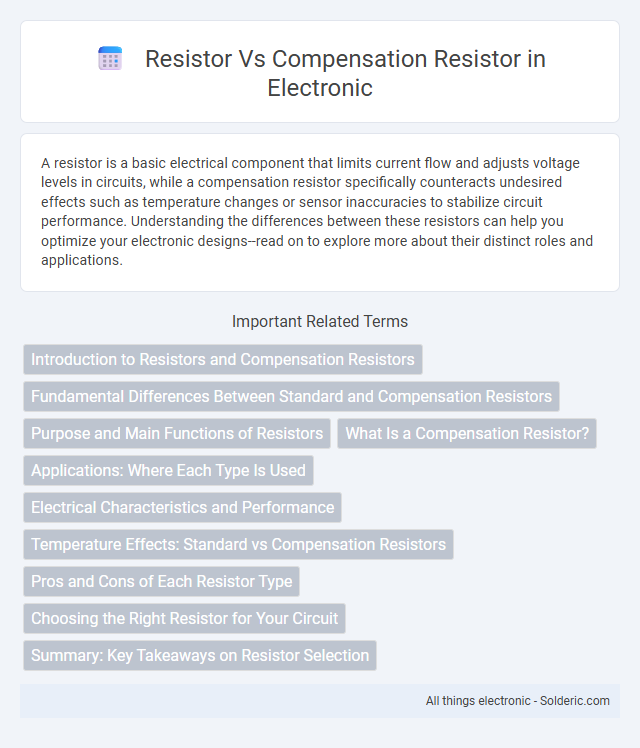A resistor is a basic electrical component that limits current flow and adjusts voltage levels in circuits, while a compensation resistor specifically counteracts undesired effects such as temperature changes or sensor inaccuracies to stabilize circuit performance. Understanding the differences between these resistors can help you optimize your electronic designs--read on to explore more about their distinct roles and applications.
Comparison Table
| Feature | Resistor | Compensation Resistor |
|---|---|---|
| Purpose | Limit current and divide voltage in circuits | Corrects or compensates for temperature or measurement errors |
| Function | Provides predictable resistance to control electrical flow | Adjusts circuit parameters to maintain accuracy under varying conditions |
| Typical Use | General electronics: voltage division, current limiting | Precision applications: temperature sensors, bridge circuits |
| Resistance Value | Fixed or variable based on circuit requirements | Chosen to offset specific error characteristics |
| Temperature Coefficient | Varies, but often minimal impact | Designed with known temperature coefficient for error compensation |
Introduction to Resistors and Compensation Resistors
Resistors are passive electrical components that limit current flow and divide voltage within circuits, characterized by resistance values measured in ohms. Compensation resistors are specialized resistors used to counteract the effects of environmental changes such as temperature variations, ensuring circuit stability and accuracy. Their application is crucial in precision circuits and sensor systems to maintain consistent performance under fluctuating conditions.
Fundamental Differences Between Standard and Compensation Resistors
Standard resistors provide a fixed resistance value used for controlling current and voltage in circuits, characterized by tolerance, power rating, and temperature coefficient. Compensation resistors are specifically designed to counteract temperature-induced resistance variations in other components, maintaining circuit stability by matching the temperature coefficient of the device being compensated. The fundamental difference lies in their application: standard resistors set resistance levels, while compensation resistors adjust dynamically to environmental changes to preserve accurate system performance.
Purpose and Main Functions of Resistors
Resistors control electric current flow and adjust voltage levels in circuits, serving as fundamental components for regulating signal and power within electronic devices. Compensation resistors specifically balance discrepancies caused by environmental factors like temperature or component tolerances, ensuring circuit stability and accuracy. Both resistors and compensation resistors enhance performance by maintaining desired electrical conditions and preventing circuit malfunction.
What Is a Compensation Resistor?
A compensation resistor is a specialized resistor used to balance or offset the effects of temperature changes or other environmental factors in electronic circuits, ensuring stable and accurate performance. Unlike standard resistors that primarily limit current, compensation resistors are designed to counteract resistance variations caused by external influences, such as thermal drift in sensor applications. This makes compensation resistors critical components in precision instrumentation and measurement systems where maintaining consistent resistance is essential.
Applications: Where Each Type Is Used
Resistors are widely used in electronic circuits for current limiting, voltage division, and signal conditioning across consumer electronics, industrial equipment, and telecommunications. Compensation resistors are specifically employed in sensor circuits and bridge configurations to counteract temperature variations and maintain measurement accuracy in environments such as strain gauges and thermistors. While standard resistors provide basic resistance, compensation resistors enhance stability and precision in temperature-sensitive applications.
Electrical Characteristics and Performance
Resistors and compensation resistors differ primarily in their electrical characteristics and performance, where standard resistors provide fixed resistance to limit current or divide voltage, while compensation resistors are designed to counteract temperature-induced changes in circuit behavior. Compensation resistors typically feature low thermal drift and precise tolerance to maintain circuit stability under varying thermal conditions, ensuring accurate signal conditioning or sensor readings. Your circuit's performance improves through the use of compensation resistors, as they minimize errors caused by environmental fluctuations, leading to enhanced reliability and precision.
Temperature Effects: Standard vs Compensation Resistors
Standard resistors typically exhibit a linear increase in resistance with rising temperature, which can lead to inaccuracies in sensitive electronic circuits. Compensation resistors are designed with materials and configurations that counteract temperature-induced resistance changes, maintaining a more stable resistance value under varying thermal conditions. Understanding the temperature coefficients of these components helps you select the appropriate resistor for applications requiring precise thermal stability.
Pros and Cons of Each Resistor Type
Resistors provide stable resistance with reliable performance in various circuit applications, offering simplicity and cost-effectiveness, but they may lack precision in temperature-sensitive environments. Compensation resistors are designed to counteract temperature variations, enhancing circuit stability and accuracy; however, they tend to be more expensive and complex to implement compared to standard resistors. Understanding your specific circuit requirements helps determine whether the precision advantage of a compensation resistor outweighs the simplicity and affordability of a traditional resistor.
Choosing the Right Resistor for Your Circuit
Choosing the right resistor for your circuit involves understanding the key differences between a standard resistor and a compensation resistor. Standard resistors regulate current flow and set voltage levels, while compensation resistors adjust for temperature variations or other environmental factors to maintain circuit stability. Your selection should consider the specific application requirements and environmental conditions to optimize performance and reliability.
Summary: Key Takeaways on Resistor Selection
Choosing the right resistor involves understanding its resistance value, power rating, and tolerance to ensure proper circuit functionality, while compensation resistors are specifically used to offset other circuit elements like temperature drift or signal variations. Your resistor selection should prioritize accuracy and stability in the application context, considering factors such as noise performance and environmental conditions. Using compensation resistors can enhance overall system reliability by correcting deviations and maintaining optimal circuit behavior under varying conditions.
resistor vs compensation resistor Infographic

 solderic.com
solderic.com